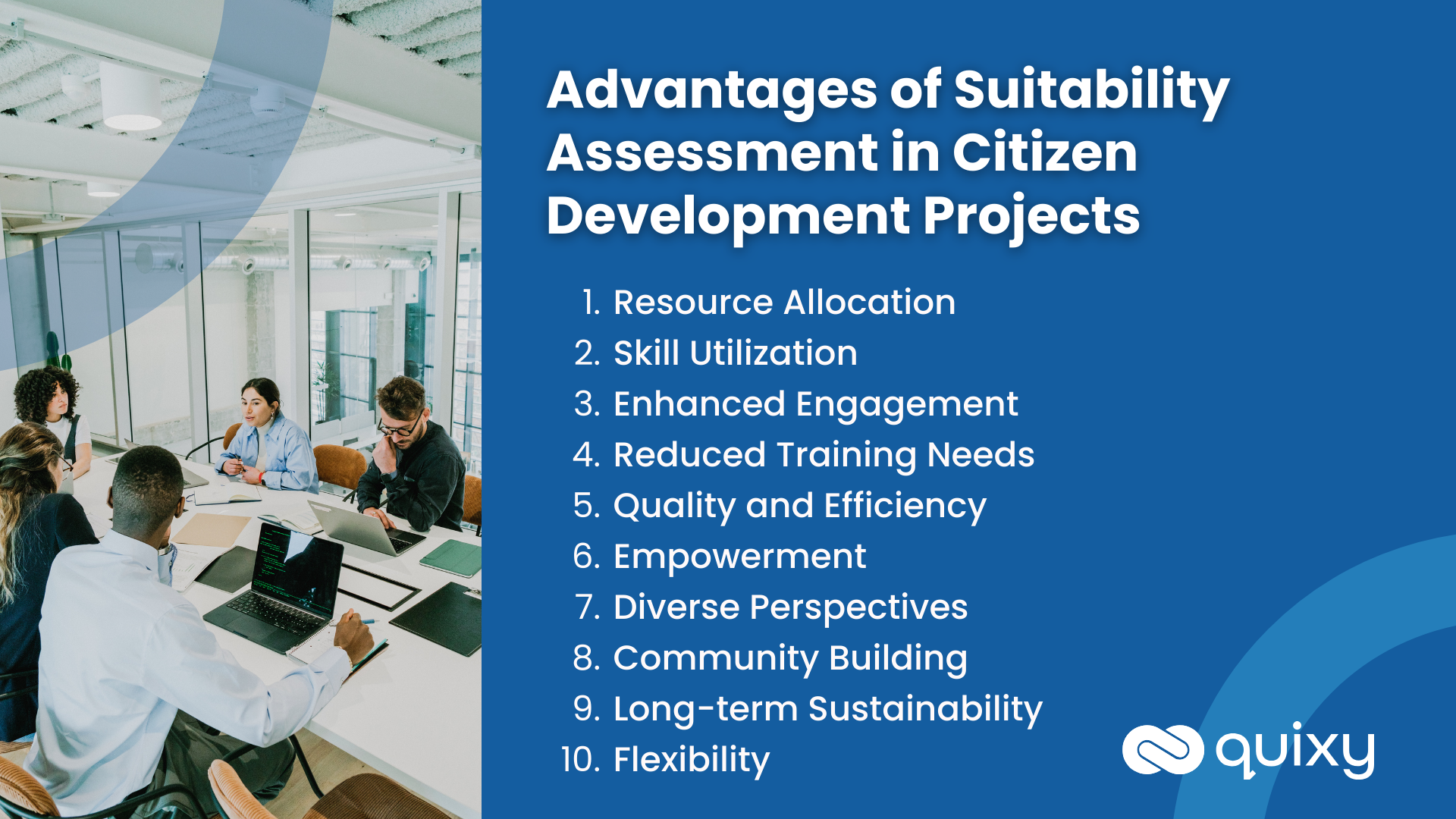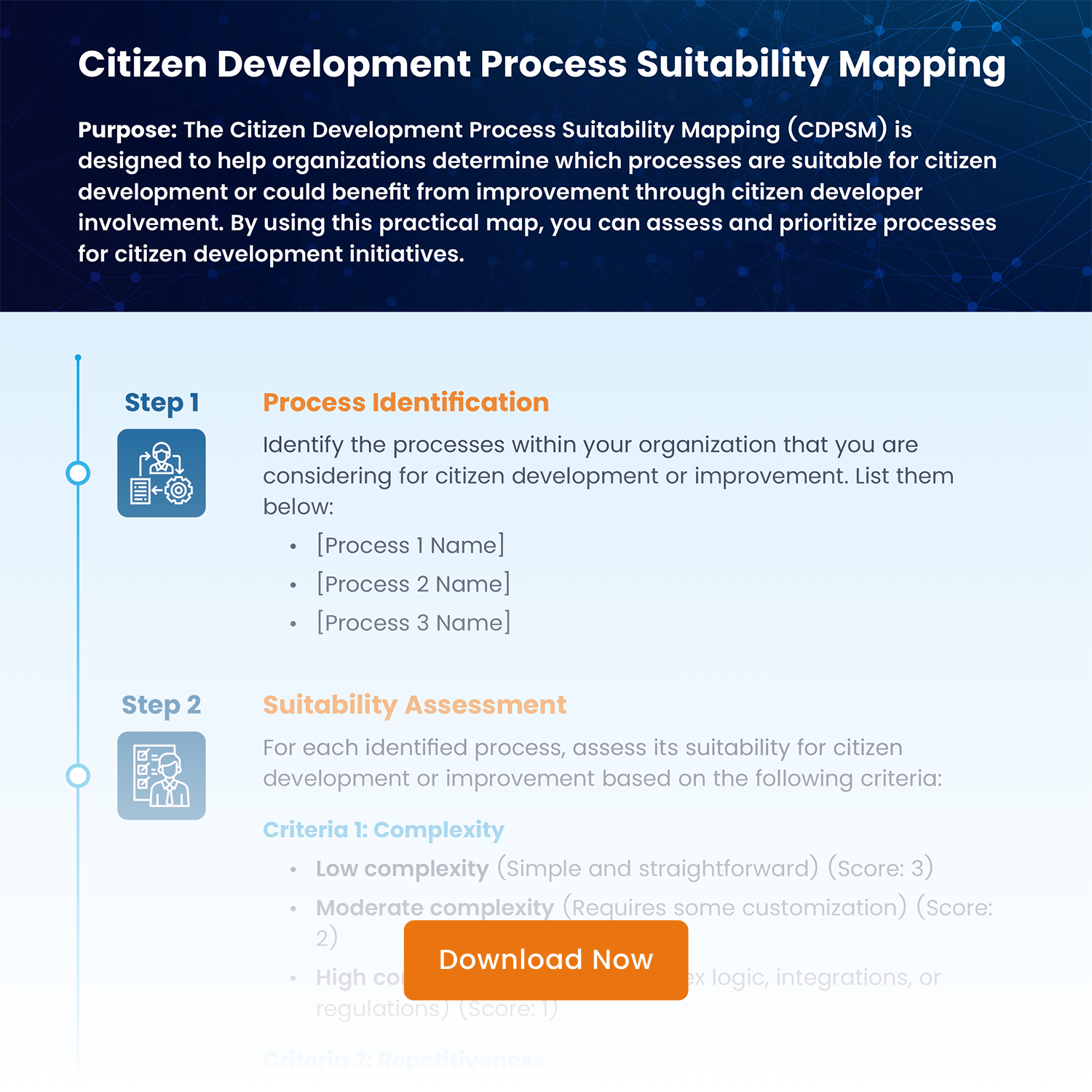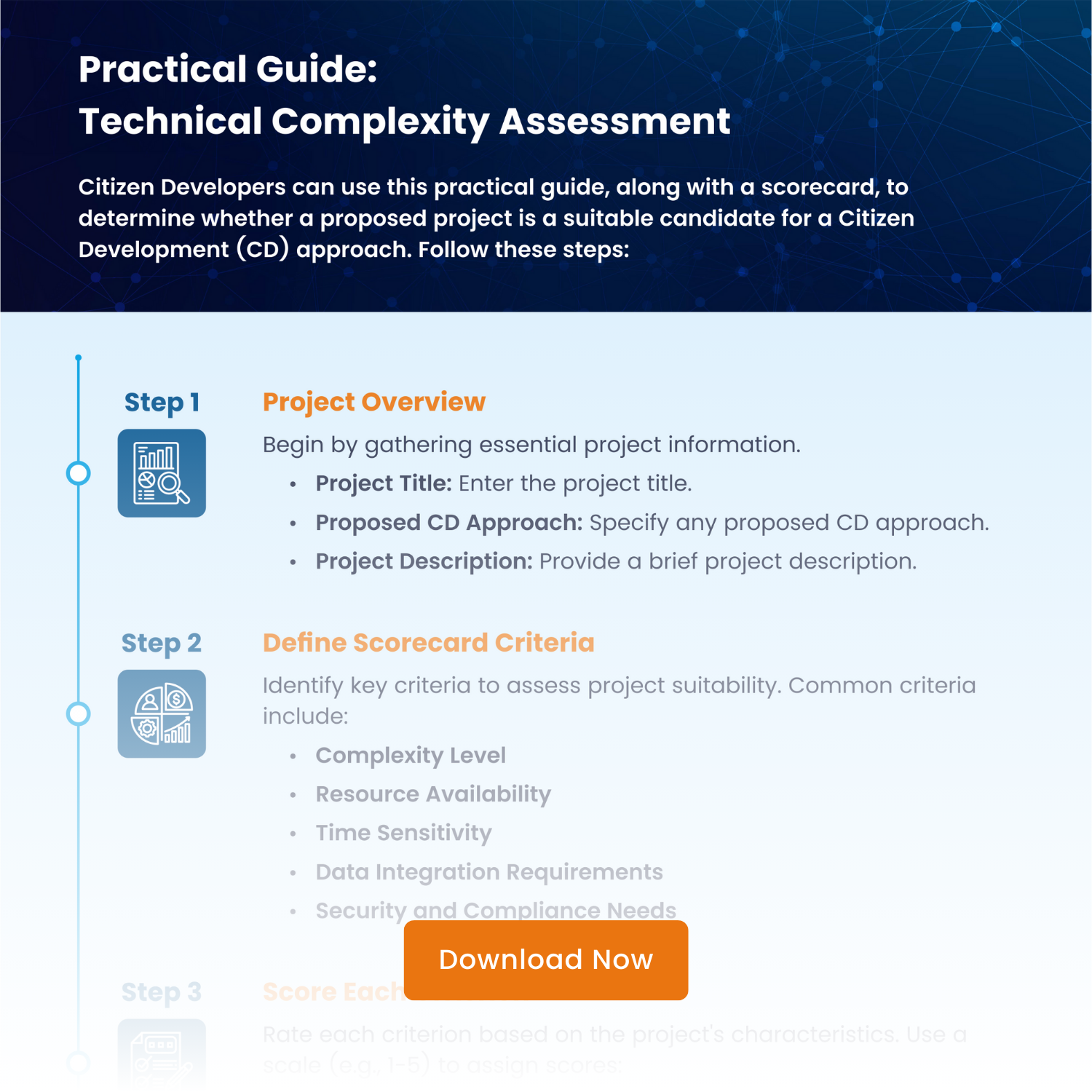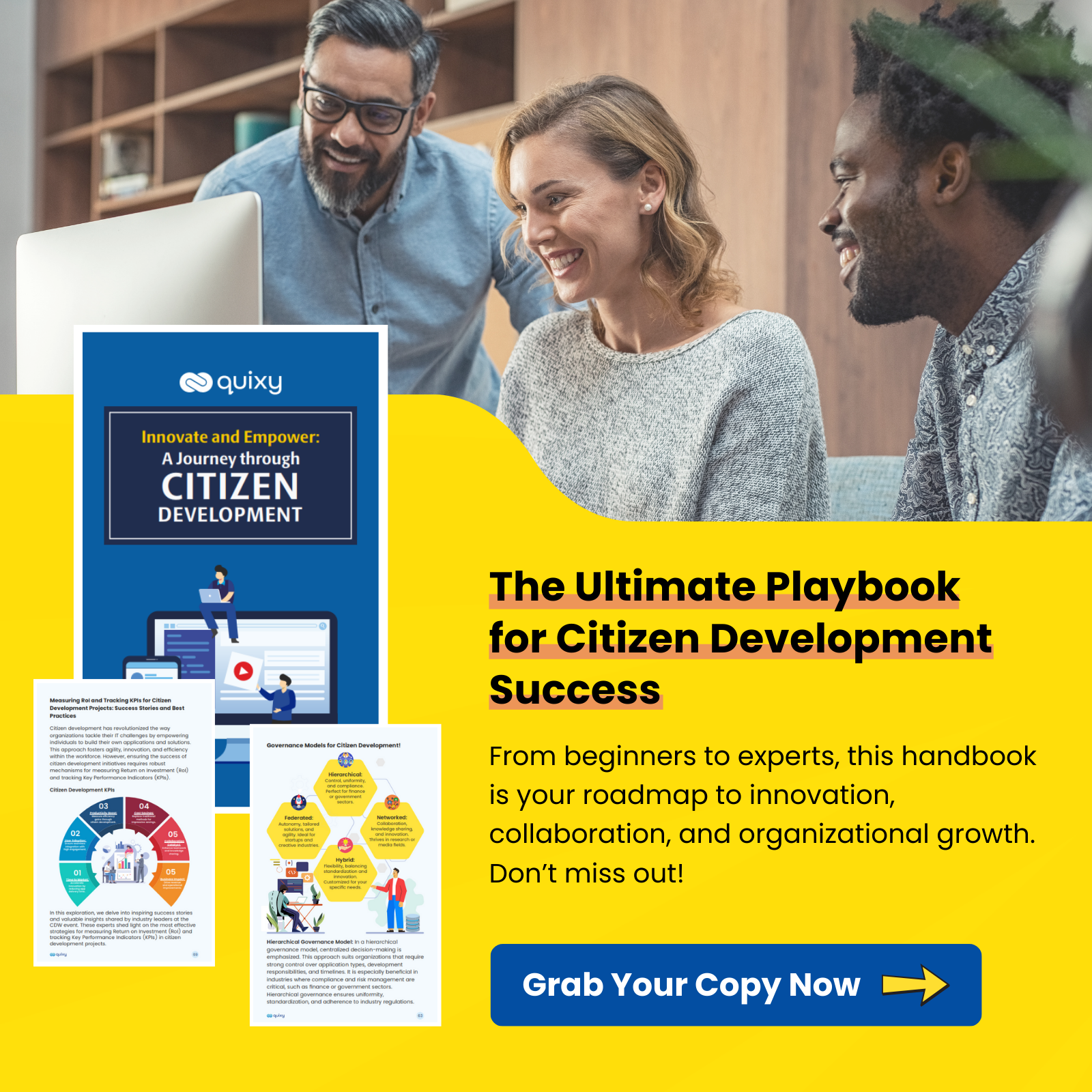
Have you ever wondered how non-technical individuals within organizations are now playing a pivotal role in creating software applications? Here, we are referring to one of the emerging revolutions of citizen development! Citizen development has become increasingly prevalent in today’s swiftly evolving digital landscape. It grants individuals without extensive technical backgrounds the power to design software applications, promising to boost productivity and innovation. But how can you discern whether a specific project is a good fit for this approach? This guide on Solution compatibility checklist will guide you through suitability assessment in citizen development, ensuring that you can make informed decisions and sidestep potential challenges.
Introduction to Citizen Development and its Power
Citizen Development is a paradigm that broadens the horizons of software creation within an organization. It invites individuals from various departments, regardless of their technical background, to participate in the development process. This inclusivity expands the versatility and scope of potential applications, allowing a diverse range of needs to be addressed.
Benefits of Faster and Simpler App Development
One of the primary advantages of citizen development is the speed and simplicity it brings to app creation. Traditional software development cycles can be lengthy and resource-intensive, but non-technical employees can create apps swiftly and efficiently with citizen development. This results in significant time and cost savings for the organization.
Understanding the Need & Advantages of Suitability Assessment

However, not all projects are suitable for citizen development. It’s vital to recognize that not every business need can be met through this approach. This is where suitability assessment comes into play. It acts as a filter to determine whether a project should proceed with citizen development or follow a more traditional development path.
Also Read: Traditional Vs Agile Project Management: Comparing and Contrasting
Suitability Assessment: Making Informed Decisions
Suitability assessment is a crucial Software Development Life Cycle (SDLC) component. It helps organizations make informed decisions about the approach to take for a particular project. By conducting a suitability assessment early in the planning phase, you can set the project on the right course from the outset.
Assessing Business Needs and Value in the Development Process
One of the first steps in suitability assessment is evaluating the business need and value of the proposed project. Is the project aligned with the organization’s strategic goals? Will it bring significant benefits or solve critical problems? Understanding the business context is essential in determining whether citizen development is a suitable choice.
The Two Parts of Suitability Assessment
Suitability assessment consists of two main parts:
- Project Evaluation: In this phase, you examine the nature of the project, its complexity, and its potential impact on the organization. You’ll also consider factors like project size and scope.
- Risk Assessment: Assessing the potential risks associated with the project is crucial. This includes identifying technical challenges, resource limitations, and potential roadblocks that citizen developers might encounter.
The Solution Compatibility Checklist: Evaluating Fit for Citizen Development

Before diving into the technical aspects of suitability assessment, it’s essential to understand why you might consider citizen development in the first place. Some common reasons include a need for rapid development, leveraging domain expertise within the organization, or addressing a specific departmental requirement.
Using the Scorecard to Assess Solution Suitability
The solution compatibility checklist is a key tool. It’s a structured way to evaluate whether a project is well-suited for citizen development. The scorecard typically consists of a set of criteria, and each criterion is given a score. These criteria include complexity, business alignment, and resource availability.
Interpreting the Score and its Implications
Once you’ve completed the checklist, you must interpret the results. A higher score indicates a higher suitability for citizen development, while a lower score may suggest that traditional development methods are more appropriate. The checklist provides valuable insights into the project’s feasibility, helping you make informed decisions.
Also Read: Accelerating Innovation with Agile Idea Development
Risk Assessment: Identifying and Mitigating Potential Risks
Risk assessment is an integral part of suitability assessment. It involves identifying potential risks and challenges that could arise during the citizen development process. Understanding these risks is crucial for making informed decisions and planning mitigation strategies.
Analyzing and Addressing Project Risks in Citizen Development
During this phase, you’ll delve into the specific risks associated with the project. These risks can vary widely, from technical challenges to resource constraints. By identifying these risks early on, you can proactively address them to minimize their impact.
Integrating Risk Mitigation Strategies into the Decision-Making Process
Once you’ve identified project risks, the next step is integrating risk mitigation strategies into the decision-making process. This might involve adjusting project timelines, allocating additional resources, or seeking external expertise to tackle specific challenges.

Technical Complexity Assessment: Gauging Development Complexity
Technical complexity assessment is essential in determining whether citizen development is a viable option for your project. You’ll need to evaluate the technical requirements and complexities associated with the proposed application.

Assessing the Feasibility of Citizen Development for Technical Challenges
Some projects may involve complex technical components that exceed the capabilities of citizen developers. In such cases, you must assess whether citizen development can feasibly address these challenges or if a different approach is more suitable.
Balancing Technical Considerations in the Suitability Assessment
Balancing technical considerations with other aspects of suitability assessment is crucial. It’s not just about whether citizen developers can handle the technical aspects; it’s also about ensuring the project aligns with the organization’s goals and has manageable risks.
Also Read: How to Implement and Govern Citizen Development
Environmental Checks: Preparing for Citizen Development
Before proceeding with citizen development, you must assess the organization’s readiness. This includes evaluating the skills and expertise of potential citizen developers, the availability of necessary tools and resources, the capacity to support the project, and the level of buy-in from key stakeholders.
Identifying Actions to Ensure Project Success
Based on your checks, you’ll need to identify actions to ensure project success. This may involve training programs, resource allocation, or communication plans to secure all stakeholders’ necessary support and commitment.
Embracing Flexibility and Adaptability in Citizen Development
Flexibility and adaptability are essential qualities in citizen development. Projects can evolve, and unexpected challenges may arise. Preparing to adjust your approach and embrace changes is key to successful citizen development.
Also Read: 10 Powerful Solutions You Can Build with No-Code Tools
Making the Decision: Finding the Right Fit
After completing all the assessments, it’s time to consider the overall results. Review the scorecard, risk assessment, and technical complexity evaluation collectively to gain a holistic view of the project’s suitability for citizen development.
Balancing Insights from Scorecard, Risk Assessment, and Technical Complexity Assessment
Achieving the right balance between these insights is crucial. A high score on the scorecard may suggest suitability, but if the risk assessment uncovers significant challenges, the approach may be reevaluated.
Empowering Informed Decision-Making in Citizen Development
Ultimately, the goal of suitability assessment is to empower informed decision-making. This ensures that you embark on citizen development projects with a clear understanding of their potential, risks, and alignment with your organization’s objectives.
Also Read: Top No-Code App Builders
Conclusion
In a hyper-agile Software Development Life Cycle (SDLC), the significance of suitability assessment becomes even more pronounced. It allows you to adapt and pivot quickly in response to changing requirements and market dynamics.
By harnessing the power of informed decision-making, organizations can maximize the benefits of citizen development while minimizing potential setbacks.
A suitability checklist is a vital tool for efficient and effective project delivery in citizen development. Embrace it as a guiding principle to ensure that your organization’s foray into citizen development is well-informed and successful.
We’ve explored various aspects of suitability assessment in citizen development. By following these steps and considering the insights provided, you’ll be better equipped to embark on citizen development projects that align with your organization’s goals, mitigate risks, and ultimately lead to successful outcomes.
Whether you’re new to citizen development or looking to optimize your existing processes, this guide is a valuable resource to help you navigate the complexities of this innovative approach to software development. Embrace the power of informed decision-making and suitability assessment to unlock the full potential of citizen development in your organization.
Frequently Asked Questions(FAQs)
Q. What is a Suitability Assessment in Citizen Development?
A Suitability Assessment in Citizen Development is a process to evaluate whether a particular project is well-suited for citizen developers. It considers factors like complexity, scope, and available resources to determine project feasibility.
Q. Why is Suitability Assessment Important in Citizen Development?
Suitability Assessment ensures that projects align with the skills and capabilities of citizen developers. It helps prevent resource wastage on projects that may be too complex or impractical for non-technical users.
Q. What Criteria Are Considered in a Suitability Assessment?
Suitability Assessments can be carried out by a combination of citizen developers, IT professionals, and project stakeholders. Collaboration between these groups is often essential.
Q. How Often Should a Suitability Assessment Be Conducted?
Suitability Assessments should ideally be conducted at the project’s inception and reviewed periodically. Regular assessments help ensure that the project remains aligned with the organization’s goals and the evolving skills of citizen developers.
Q. How to know if your project is suitable for Citizen Development or not?
To assess project suitability for Citizen Development, employ our Suitability Assessment Scorecard. Rate factors like project complexity, available resources, user requirements, and technical feasibility. Collaborate with citizen developers, IT experts, and stakeholders to ensure a well-rounded evaluation. The scorecard provides a structured approach to determine if your project aligns with the capabilities and goals of citizen development initiatives.
Q. What are the advantages of suitability assessment?
Suitability assessments offer efficient resource allocation, risk mitigation, and informed decision-making. They enhance project success, talent matching, tailored development, and stakeholder alignment. This approach ensures effective project scoping, boosts efficiency and encourages continuous improvement across various contexts, ultimately leading to better outcomes.
Subscribe
Login
Please login to comment
0 Comments
Oldest















